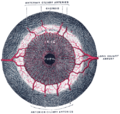Ciliary muscle
| Ciliary muscle | |
|---|---|
Vorticose vein | |
| Nerve | short ciliary Parasympathetic fibers in the oculomotor nerve (CN-III) synapse in the ciliary ganglion. Parasympathetic postganglionic fibers from the ciliary ganglion travel through short ciliary nerves into the ocular globe. |
| Actions | 1) accommodation, 2) regulation of trabecular meshwork pore sizes |
| Identifiers | |
| Latin | musculus ciliaris |
| TA98 | A15.2.03.014 |
| TA2 | 6770 |
| FMA | 49151 |
| Anatomical terms of muscle] | |
The ciliary muscle is an
Structure
Development
The ciliary muscle develops from mesenchyme within the choroid and is considered a cranial neural crest derivative.[6]
Nerve supply

The ciliary muscle receives parasympathetic fibers from the short ciliary nerves that arise from the ciliary ganglion. The parasympathetic postganglionic fibers are part of cranial nerve V1 (Nasociliary nerve of the trigeminal), while presynaptic parasympathetic fibers to the ciliary ganglia travel with the oculomotor nerve.[7] The postganglionic parasympathetic innervation arises from the ciliary ganglion.[8]
Presynaptic parasympathetic signals that originate in the
The parasympathetic tone is dominant when a higher degree of accommodation of the lens is required, such as reading a book.[9]
Function
Accommodation
The ciliary fibers have circular (Ivanoff),
According to
Trabecular meshwork pore size
Contraction and relaxation of the longitudinal fibers, which insert into the
Clinical significance
Glaucoma
Open-angle glaucoma (OAG) and closed-angle glaucoma (CAG) may be treated by muscarinic receptor agonists (e.g., pilocarpine), which cause rapid miosis and contraction of the ciliary muscles, opening the trabecular meshwork, facilitating drainage of the aqueous humour into the canal of Schlemm and ultimately decreasing intraocular pressure.[14]
History
Etymology
The word ciliary had its origins around 1685–1695.
Additional images
-
The arteries of the choroid and iris. The greater part of the sclera has been removed.
-
Iris, front view.
See also
- Accommodation reflex
- Cycloplegia
- Extraocular muscle
- Presbyopia
References
- ^ a b Gest, Thomas R; Burkel, William E. "Anatomy Tables - Eye." Medical Gross Anatomy. 2000. University of Michigan Medical School. January 5, 2010 Umich.edu Archived 2010-05-26 at the Wayback Machine
- ISBN 978-1-4058-8118-0.
- ^ S2CID 45247729.
- ISBN 978-9-062-99233-1.
- PMID 25750232.
- ISBN 978-1-60547-901-9.
- ISBN 0-7817-3639-0.
- PMID 25589275.
- ISBN 978-0-07-162442-8.
- ISBN 978-3-540-69144-0.
- ^ Riordan-Eva Paul, "Chapter 1. Anatomy & Embryology of the Eye" (Chapter). Riordan-Eva P, Whitcher JP (2008). Vaughan & Asbury's General Ophthalmology (17th ed.). McGraw-Hill. AccessMedicine.com Archived 2009-07-06 at the Wayback Machine
- ISBN 978-0-07-162442-8.
- ^ Salmon John F, "Chapter 11. Glaucoma" (Chapter). Riordan-Eva P, Whitcher JP (2008). Vaughan & Asbury's General Ophthalmology (17th ed.). McGraw-Hill. AccessMedicine.com Archived 2009-07-06 at the Wayback Machine
- ^ Le, Tao T.; Cai, Xumei; Waples-Trefil, Flora. "QID: 22067". USMLERx. MedIQ Learning, LLC. 2006–2010. 13 January 2010 Usmlerx.com Archived 2012-10-26 at the Wayback Machine
- ^ "cilia", Unabridged. Source location: Random House, Inc. Reference.com. Retrieved on 2010-01-16 from http://dictionary.reference.com/browse/cilia.
- ^ Dictionary.com, "-ary", in The American Heritage Dictionary of the English Language, Fourth Edition. Source location: Houghton Mifflin Company, 2004. Reference.com. Retrieved on 2010-01-16 from http://dictionary.reference.com/browse/-ary.
- ^ "ciliary," in Dictionary.com Unabridged. Source location: Random House, Inc. Reference.com. Retrieved on 2010-01-16 from http://dictionary.reference.com/browse/ciliary.
External links
- Lens, zonule fibers, and ciliary muscles—SEM Archived 2011-09-28 at the Wayback Machine



